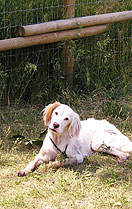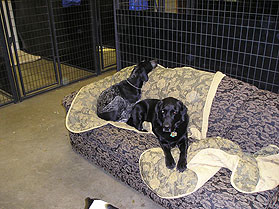What is the bordetella vaccination, and why does my dog need it?
 In the simplest of terms, the bordetella vaccination is the canine equivalent of the human flu shot. It helps protect your dog from contracting canine cough. Just like the human flu, canine cough is both seasonal (usually spring and fall) and epidemic. For this reason, we recommend vaccinating every six months instead of once a year. Your dog is more likely to come into contact with the virus in areas that frequently have large numbers of dogs. This can be a dog park, a boarding facility, a shelter, or even the veterinarian’s office. Dogs can carry the virus without being ill or showing any symptoms. Dogs can also still get canine cough even though they have been vaccinated. Just like the human flu shot, the bordetella vaccination only HELPS protect your dog from the virus. If your dog does contract canine cough, there is no medicine that the vet can give you to get rid of the virus. Just like the human flu bug, canine cough simply needs to run its course. However, your vet can prescribe medications to ease some of the symptoms and guard against secondary infections. If you suspect that your dog has canine cough, it is best to call your vet and get a recommendation on the best course of action for your particular dog.
In the simplest of terms, the bordetella vaccination is the canine equivalent of the human flu shot. It helps protect your dog from contracting canine cough. Just like the human flu, canine cough is both seasonal (usually spring and fall) and epidemic. For this reason, we recommend vaccinating every six months instead of once a year. Your dog is more likely to come into contact with the virus in areas that frequently have large numbers of dogs. This can be a dog park, a boarding facility, a shelter, or even the veterinarian’s office. Dogs can carry the virus without being ill or showing any symptoms. Dogs can also still get canine cough even though they have been vaccinated. Just like the human flu shot, the bordetella vaccination only HELPS protect your dog from the virus. If your dog does contract canine cough, there is no medicine that the vet can give you to get rid of the virus. Just like the human flu bug, canine cough simply needs to run its course. However, your vet can prescribe medications to ease some of the symptoms and guard against secondary infections. If you suspect that your dog has canine cough, it is best to call your vet and get a recommendation on the best course of action for your particular dog.
Do you give the bordetella vaccination at the facility?
Although many facilities do give you the option of receiving the vaccination at check in, we do not provide this service. First, giving the vaccination when your dog is dropped off for boarding creates a gap in protection. There are two ways to vaccinate your dog against bordetella. There is a subcutaneous injection or a nasal spray. The subcutaneous injection takes approximately 5 days to provide complete protection. The nasal spray provides faster protection, but full coverage still takes a day or two. So, if your dog receives the vaccination from me at check in, it will still be susceptible to the virus for at least the first day.
The second reason is that while neither method of vaccination is particularly painful, it does still create a certain amount of unnecessary stress for the pet. Entering the boarding facility, with all of its new smells and noises, can be stressful enough and we strive to make each pet’s boarding experience as enjoyable as possible. For us, this means greeting him/her with a favorite toy or a good belly rub, and not with a vaccination.
Do I need to bring food/water dishes for my pet?
You do not need to bring any dishes with your pet, unless your dog requires an elevated feeder. We provide all food and water dishes for all pets. This makes breakfast and dinner preparation easier for us, and it makes packing for your pet easier for you.
Can I bring a bed/blanket and toys for my pet?
You may bring anything from home that you feel your pet would enjoy while they are in their kennel at night. All that we ask is for any bedding to be washable (just in case☺), and that you limit the number of toys to 3. If you have a dog that is crate trained, or a puppy that you are trying to crate train, feel free to bring the crate. The kennels are large enough for even the largest crates to fit in. If you have any questions about certain items please feel free to ask when you make the reservation.
Can I bring special treats for my pet?
Yes, especially if your dog enjoys chews or has become conditioned to expect treats at certain times or for certain behaviors. We will gladly give your pet any special treats that you want to bring. In our experience, dogs that enjoy bones and other chews, have an easier time adjusting to their kennel when they are given something to ‘keep them busy’ the first night they stay with us. Since many owners are very careful about what they allow their dog to eat, we do not provide chews for any of the boarding dogs. However, if you want to bring something from home we are happy to give it to your dog while you are away. Dogs that are used to getting treats at specific times of day, or for performing certain behaviors (going potty, for example) also adjust more quickly to the kennel routine when these at-home treat times are reinforced while they are boarding. If you have a treat-giving routine at home, please specify the details when you are filling out the pet information sheet. Be as detailed as possible so that we can reinforce the routine appropriately.
How much time does my dog get to spend out of his/her kennel?
The exact amount of time will vary day to day, depending on the particular group of dogs that we have boarding each day. On average, it will range between 6 and 8 hours each day. On days that we have very social and well behaved dogs, the total time out of their kennels could reach 10 hours. On days that most of the dogs require individual attention and exercise, the average time could drop to 4 hours. We strive to provide the maximum amount of ‘free time’ to each dog, but do so only in a safe, supervised and low-stress environment.
What do you do if my dog doesn’t get along with the other dogs?
If we feel that your dog isn’t doing well with the other dogs, we willseparate him/her from the group. During socialized playtimes they will either remain in their kennel or be limited to a separate play area. We will do this for a number of reasons, not just for overly dominant or aggressive dogs. If your dog displays signs of shyness, fear, anxiety, or otherwise appears uncomfortable in the socialized pack, we will keep his/her exercise and playtime limited to human interaction. Many times older dogs, young puppies, dogs with medical conditions, only pets, and working dogs that have a very strong bond with their owner may feel overwhelmed by a group of unfamiliar dogs in an unfamiliar setting. Sometimes, as your dog becomes more accustomed to the daily routine of the kennel, he/she may begin to gain more interest and confidence in playing with the other dogs. As this happens, we will slowly introduce your dog to one or two of the other boarders. If you have specific concerns about your dog being socialized please ask/inform me.
Will my little dog be put out to play with the large ones?
This depends entirely on how comfortable your little dog is around larger dogs. We select playgroups based upon size, age, activity level, and play style, and all dogs are screened before they are allowed to socialize. So, for example, all of the large dogs that enjoy chasing tennis balls and are not toy possessive/aggressive will be exercised together. The same goes for all of the large dogs that enjoy wrestling, all of the small dogs that enjoy playing chase, all of the elderly dogs that enjoy sniffing each other then laying down, etc.
If I have an emergency, what is the best way to get in touch with you?
 The business phone number is the absolute best way to get in touch with us. It is a cell phone and we keep it with us at all times. If you do get the message box, please leave one! If we happen to miss your call, we check the messages as soon as we can, and will make every effort to accommodate you. If you do not leave a message then we cannot guarantee that we will be able to meet your needs.
The business phone number is the absolute best way to get in touch with us. It is a cell phone and we keep it with us at all times. If you do get the message box, please leave one! If we happen to miss your call, we check the messages as soon as we can, and will make every effort to accommodate you. If you do not leave a message then we cannot guarantee that we will be able to meet your needs.
